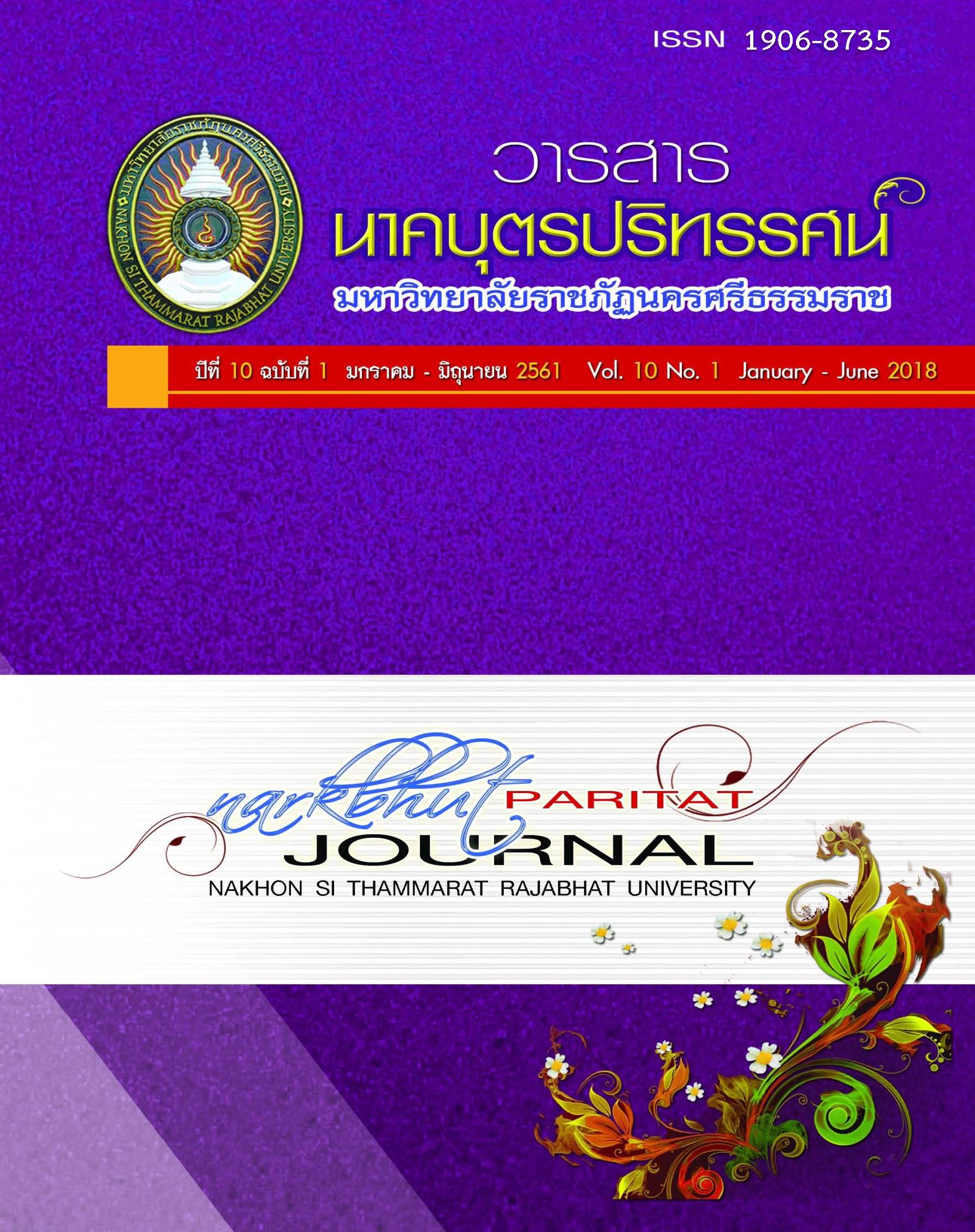การพัฒนาบทเรียนอิเล็กทรอนิกส์แบบปฏิสัมพันธ์ผ่านเครือข่ายสังคมและคลาวด์เลิร์นนิง กลุ่มสาระการเรียนรู้การงานอาชีพและเทคโนโลยี ระดับชั้นประถมศึกษาปีที่ 6 The Development of Interactive e-Learning Courses Through Social networks and Cloud Learning in Career a
Main Article Content
Abstract
บทคัดย่อ
การวิจัยครั้งนี้มีวัตถุประสงค์เพื่อพัฒนาและประเมินประสิทธิภาพบทเรียนอิเล็กทรอนิกส์แบบปฏิสัมพันธ์ผ่านเครือข่ายสังคมและคลาวด์เลิร์นนิง ประเมินประสิทธิผลการใช้บทเรียนอิเล็กทรอนิกส์แบบปฏิสัมพันธ์ผ่านเครือข่ายสังคมและคลาวด์เลิร์นนิง วัดความคงทนในการเรียนรู้ของนักเรียนหลังการใช้บทเรียนอิเล็กทรอนิกส์แบบปฏิสัมพันธ์ผ่านเครือข่ายสังคมและคลาวด์เลิร์นนิง กลุ่มสาระการเรียนรู้การงานอาชีพและเทคโนโลยี ระดับชั้นประถมศึกษาปีที่ 6 ใช้ระเบียบวิธีวิจัยแบบผสมผสาน คือ การวิจัยเชิงปริมาณและการวิจัยคุณภาพ กลุ่มตัวอย่าง ได้แก่ นักเรียนระดับชั้นประถมศึกษาปีที่ 6 โรงเรียนบ้านคอกช้าง จำนวน 32 คน และครูผู้สอนกลุ่มสาระการเรียนรู้การงานอาชีพและเทคโนโลยี จำนวน 5 คน ได้มาโดยวิธีการเลือกแบบเจาะจง เครื่องมือที่ใช้ในการวิจัย ได้แก่ แบบบันทึกข้อมูล แบบสัมภาษณ์นักเรียน แบบประเมินคุณภาพของบทเรียน แบบทดสอบวัดผลสัมฤทธิ์ทางการเรียน แบบสอบถามความพึงพอใจของนักเรียน แบบสอบถามความคิดเห็นของครูผู้สอนและแบบวัดความคงทนทางการเรียน การวิเคราะห์ข้อมูล ได้แก่ การวิเคราะห์เนื้อหา การหาค่าร้อยละการหาค่าเฉลี่ย ( ) ส่วนเบี่ยงเบนมาตรฐาน (S.D.) การทดสอบค่าที (t-test dependent samples) ผลการวิจัยพบว่า
- บทเรียนอิเล็กทรอนิกส์แบบปฏิสัมพันธ์ผ่านเครือข่ายสังคมและคลาวด์เลิร์นนิงกลุ่มสาระการเรียนรู้การงานอาชีพและเทคโนโลยี ระดับชั้นประถมศึกษาปีที่ 6 มีองค์ประกอบ 4 องค์ประกอบ ดังนี้บทเรียนอิเล็กทรอนิกส์ ระบบบริหารจัดการเรียน การติดต่อสื่อสาร การประเมิน
บทเรียนอิเล็กทรอนิกส์แบบปฏิสัมพันธ์ผ่านเครือข่ายสังคมและคลาวด์เลิร์นนิง กลุ่มสาระการเรียนรู้การงานอาชีพและเทคโนโลยี ระดับชั้นประถมศึกษาปีที่ 6 มีประสิทธิภาพ (E1\E2) 82.71/81.70 สูงกว่าเกณฑ์ที่กำหนด (80/80)
- ประสิทธิผลการใช้บทเรียนอิเล็กทรอนิกส์แบบปฏิสัมพันธ์ผ่านเครือข่ายสังคมและคลาวด์เลิร์นนิง กลุ่มสาระการเรียนรู้การงานอาชีพและเทคโนโลยี ระดับชั้นประถมศึกษาปีที่ 6 พบว่า นักเรียนมีผลสัมฤทธิ์ทางการเรียนหลังเรียนสูงกว่าก่อนเรียน อย่างมีนัยสำคัญทางสถิติที่ระดับ .05 นักเรียนมีความพึงพอใจต่อบทเรียนอิเล็กทรอนิกส์แบบปฏิสัมพันธ์ผ่านเครือข่ายสังคมและคลาวด์เลิร์นนิง โดยภาพรวมอยู่ในระดับมาก ครูผู้สอนมีความคิดเห็นเกี่ยวกับบทเรียนอิเล็กทรอนิกส์แบบปฏิสัมพันธ์ผ่านเครือข่ายสังคมและคลาวด์เลิร์นนิง โดยภาพรวมอยู่ในระดับมาก นักเรียนที่เรียนด้วยบทเรียนอิเล็กทรอนิกส์แบบปฏิสัมพันธ์ผ่านเครือข่ายสังคมและคลาวด์เลิร์นนิง มีความคงทนในการเรียนรู้หลังผ่านไป 2 สัปดาห์ ไม่แตกต่างกับผลสัมฤทธิ์ทางการเรียนหลังเรียนทันที อย่างมีนัยสำคัญทางสถิติที่ระดับ .05
คำสำคัญ : บทเรียนอิเล็กทรอนิกส์ ,แบบปฏิสัมพันธ์,เครือข่ายสังคม,คลาวด์เลิร์นนิง
Abstract
The objectives of this research are to to develop the effectiveness of interactive e-learning courses through social networks and cloud learning, to evaluate the effectiveness of interactive e-learning through social networks and cloud learning, and to measure the durability of student learning. after using interactive e-learning courses through social networks and cloud learning in career and technology group for grade 6 students. The integrated research methodologies were quantitative research and quality research. The target group included 32 students in grade 6 at Ban Khok Chang School and 5 teachers of career and technology group : they were selected by purposive selection. The instruments of this research were a record form, students’ structured interview, evaluation of the quality of lessons, a learning achievement test, an evaluation form of students’ satisfaction, a questionnaire on teachers’ opinions, and a learning retention measurement. The collected data were analyzed by content analysis, percentage, mean, standard deviation, and t-test dependent.
The research results indicated that
- The interactive e-learning courses through social networks and cloud learning in career and technology group for grade 6 students comprised of 4 concepts which were 1) lessons, 2) learning management systems, 3) communication, and 4) evaluation.
The interactive e-learning courses through social networks and cloud learning in career and technology group for grade 6 students had the efficiency at the 82.71 / 81.70 which was higher than the threshold (80/80).
- After using the interactive e-learning courses through social networks and cloud learning in career and technology group for grade 6 students showed that
2.1 The students’ posttest score was higher than pretest score which was significant different at the level of .05 .
2.2. The students’ satisfaction towards the interactive e-learning courses through social networks and cloud learning in career and technology group for grade 6 students was at a high level.
2.3 The opinions of teachers towards the interactive e-learning courses through social networks and cloud learning in career and technology group for grade 6 students was at a high level.
- The students who had learnt through the interactive e-learning courses through social networks and cloud learning could retain their knowledge after they had learnt for two weeks. Their scores did not differ from the posttest scores that were significant different at the level of .05 .
Article Details
References
Dudeney, G. & Hockly, N. (2007). How to Teach English with Technology. Harlow: Pearson Education Limited.
Daron Ratanpunsan. (2002). The importance and role of e-Learning in e-Learning. Bangkok Big C: TJ Book. (in Thai)
Jaturong Trirat. (2011). Development of e-learning lessons. Information Technology The students' Independent Research Master of Education Educational Technology Silpakorn University. (in Thai)
Jintavee Khlaisang. (2012). E-learning cure Practical concepts for e-learning at all levels. Bangkok: Chulalongkorn University. (in Thai)
Jintavee Khlaisang. (2012). Learning course program. Concept into practice for teaching e-learning at all levels. Bangkok University Chulabhorn. (in Thai)
Kittisak Sotha. (2012). Development of computer lessons on the network. Learning Objectives and Technology for Using Microsoft PowerPoint 2007, Prathomsuksa 6, Sakon Nakhon. (in Thai)
Kanda Roonna. (2013). Social Media: 1. [Online] Available: http://gear.kku.ac./gunapon/ talks / socialmedia / kku-socialmedia.pdf, [2559, January 12] (in Thai)
Monchai Teantong. (2005). Design and development of software for computer-assisted instruction. Bangkok: King Mongkut's Institute of Technology North Bangkok. (in Thai)
Pakjira rodpon. (2010). Development of e-learning lessons with learning support. History of Sukhothai For Prathom Suksa 1 students. Master of Education Thesis Silpakorn University. (in Thai)
Sorat Hongladarom. (2002). Science and Culture in Thailand. Bangkok: Institute of Development Research. (in Thai)
Sutida Thkang. (2016,January-June). Information Perception Development to Learning Encouragement for children with Special Needs of Nakhon Si Thammarat Primary Educational Service Area office 2. Narkbhut Paritat journal. 8(1), 45-60.
Thanom Phornjarusang. (2002). The Effects of Using Electronic Learning (e-Learning) The Basic English Course The results of the study were as follows. Chiang Mai: Chiang Mai University. (in Thai)
Thanyarat Suksorn. (2012). Development of multimedia computer course on elemental and radioactive elements. To promote learning achievement and learning retention of the students in the fourth grade. Master of Science (Chemistry). Srinakharinwirot University. (in Thai)
Thapana Thammathira. (2014).ELearning: From Theory to Practice e-Learning: from theory to practice. Bangkok: University of the Thai Chamber of Commerce. Office of the Higher Education Commission. (in Thai)
Watcharapol Vibulyasin. (2013). Innovative Media for Teaching Thai. Bangkok: Chulalongkorn University. (in Thai)
wijan panit. (2013). The way to make learning for the 21st century. 1st edition. Bangkok: Public Publishing Co., Ltd. (in Thai)
Yeen PhoVorawan. (2013). Emerging Technologies Conference Proceedings of the 9th Naresuan Research Conference 28-29 July 2013. Phitsanulok: Naresuan University. (in Thai)


